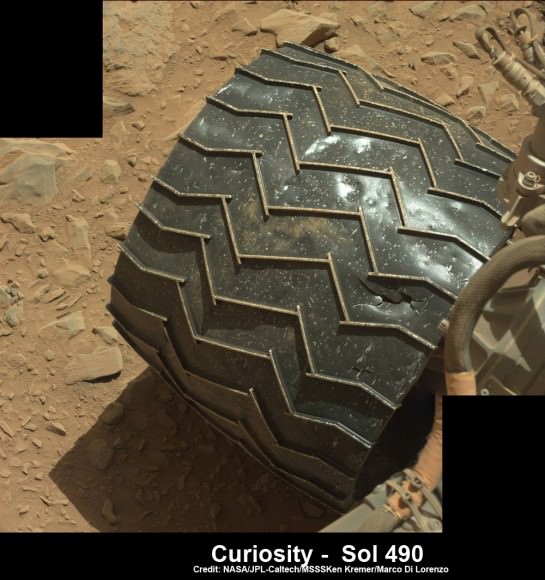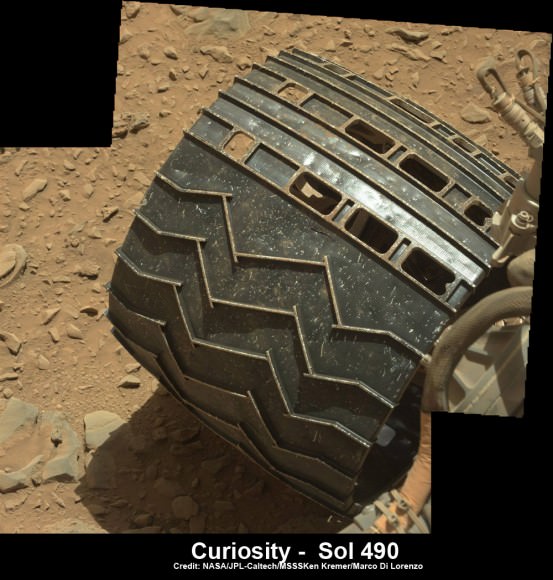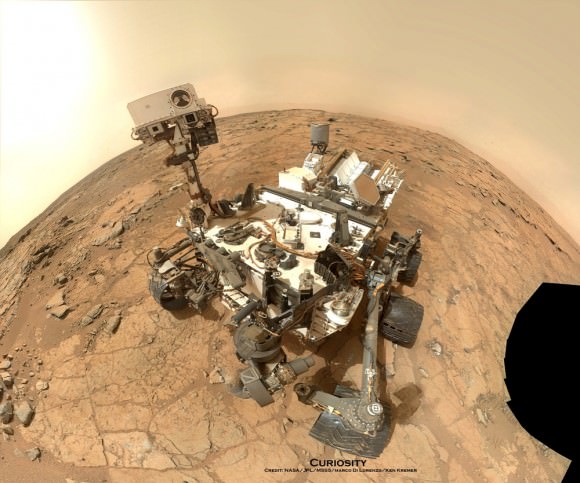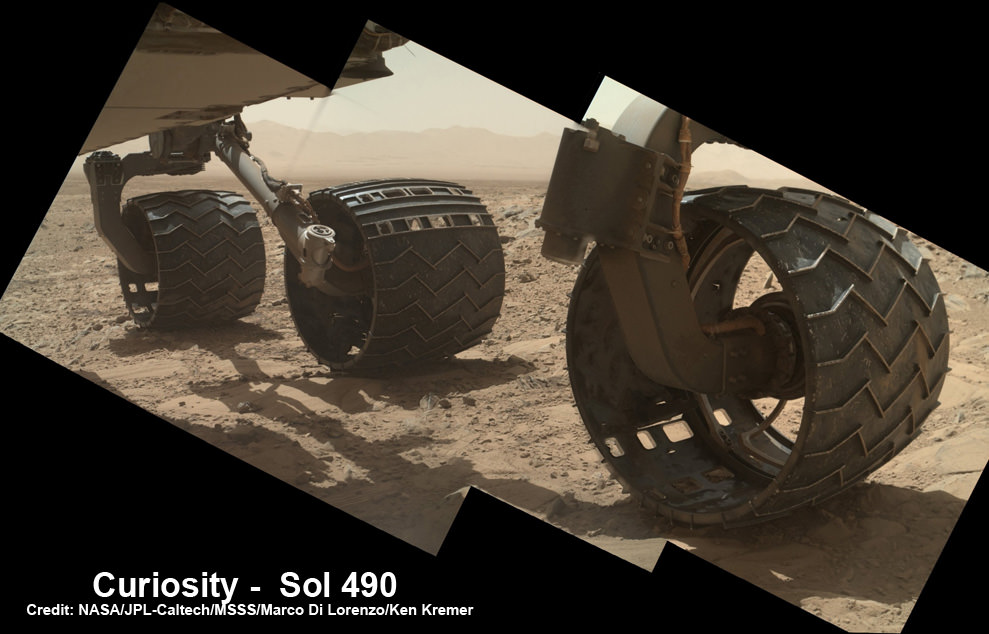Photomosaic shows new holes and tears in several of rover Curiosity’s six wheels caused by recent driving over sharp edged Martian rocks on the months long trek to Mount Sharp. Raw images taken by the MAHLI camera on Curiosity’s arm on Dec. 22, 2013 (Sol 490) were assembled to show some recent damage to several of its six wheels – most noticeably the two here in middle and front. Credit: NASA / JPL / MSSS / Marco Di Lorenzo / Ken Kremer- kenkremer.com
See below complete 6 wheel mosaic and further wheel mosaics for comparison
[/caption]
Rough edged rocks on the Red Planet are clearly taking their toll on rover Curiosity’s hi tech wheels as she speeds towards her ultimate goal – humongous Mount Sharp – in search of the ingredients necessary to sustain potential Martian microbes.
Several of the NASA rovers six big aluminum wheels have suffered some significant sized rips, tears and holes up to several centimeters wide – in addition to numerous dents – as she has picked up the driving pace across the rugged, rock filled Martian terrain this past fall and put over 4.5 kilometers (3 mi.) on the odometer to date.
It’s rather easy to spot the wheel damage to the 1 ton behemoth by examining the mosaic imagery we have created – See above and below – from newly transmitted raw imagery and comparing that to older imagery taken at earlier points in the mission. Check our Sol 177 wheels mosaic below.
The latest imagery from Mars captured just prior to Christmas is delivering an undesired holiday present of sorts to team members that might well cause the scientists and engineers to alter Curiosity’s extraterrestrial road trip to traverse smoother terrain and thereby minimize future harm.
So the wheel damage is certainly manageable at this point but will require attention.
The team of Marco Di Lorenzo and Ken Kremer have assembled the new Mastcam and MAHLI raw images of the wheels captured on Sol 490 (Dec. 22) into fresh color mosaics – shown herein.

See below more wheel mosaics for comparison

Indeed the rovers handlers have already directed the SUV sized Curiosity to snap close up images of the 20 inch diameter wheels with the high resolution color cameras located on the Mast as well as the Mars Hand Lens Imager (MAHLI) camera at the end of the rover’s maneuverable robotic arm.
“We want to take a full inventory of the condition of the wheels,” said Jim Erickson of NASA’s Jet Propulsion Laboratory, project manager for the NASA Mars Science Laboratory Project, in a NASA statement.

The rover team certainly expected some wear and tear to accumulate along the rock strewn path to the base of Mount Sharp – which reaches 5.5 km (3.4 mi) into the Martian sky.
But the volume of sharp edged rocks encountered in the momentous trek across the floor of Curiosity’s Gale Crater landing site apparently has picked up- as evidenced by the new pictures – and consequently caused more damage than the engineers anticipated.
“Dents and holes were anticipated, but the amount of wear appears to have accelerated in the past month or so,” Erickson noted.
“It appears to be correlated with driving over rougher terrain. The wheels can sustain significant damage without impairing the rover’s ability to drive. However, we would like to understand the impact that this terrain type has on the wheels, to help with planning future drives.”
The team is now inspecting the new imagery acquired of the wheels and will decide if a course alteration to Mount Sharp is in order.
The left front wheel may have suffered the most harm.

“Routes to future destinations for the mission may be charted to lessen the amount of travel over such rough terrain, compared to smoother ground nearby,” says NASA.
Following a new, post Christmas drive today, Dec. 26, 2013 (Sol 494) Curiosity’s odometer stands at 4.6 kilometers.
Curiosity has already accomplished her primary goal of discovering a habitable zone on Mars that could support Martian microbes if they ever existed.
NASA’s rover Curiosity uncovered evidence that an ancient Martian lake had the right chemical ingredients that could have sustained microbial life forms for long periods of time – and that these habitable conditions persisted on the Red Planet until a more recent epoch than previously thought.
Right now the researchers are guiding Curiosity along a 10 km (6 mi) path to the lower reaches of Mount Sharp – which they hope to reach sometime in mid 2014.

Stay tuned here for Ken’s continuing Curiosity, Chang’e-3, LADEE, MAVEN, Mars rover and MOM news.


Does the Lemon Law apply to Rovers? This Rover looks like a real dog compared to the use we got out of Spirit and Opportunity. Made in China?
This rover is way heavier.
Gee, who would have thought to compensate for that in the “rubber”? Not the US comfort-zoned Engineers, thats who. Cripes
thats a terrible comment
Hmm… sorry I missed it? Not….
Everything has beauty, but not everyone sees it.
– Confucius
Ted, don’t say anything less than glowing about Curiosity here else suffer a hail of vitriol from the denizens of Krystal. . No, this glorious mission is only to find out if Mars once could have supported life. When you aim low enough you can’t fail. Even if you feckup the tyres! ha…don’t werry USAmericans…a pretty Jade Rabbit will soon be there to carry your load. Ken Kremer…its a fair comment and one you should think about before finding wanting. This is equivalent to the mission your “engineers” botched because they forgot to convert to SI units. You need to look hard, very hard into the Uncle in the mirror, as in Sam. And you won’t appreciate that in all other walks of life I am your strongest supporter in spite of your slack-ass failings we need you all to wake up. We are the world. We need you leading space exploration. now get with it.
I believe what you’re doing is “relishing in self hatred” – because you’re very busy painting a situation of “we have a technical concern” into “Our engineers are not any good or even really engineers, our entire system sucks, and even the Chinese are better than us, and where’s my waaaaambulance”.
Seriously – this rover is hugely more capable than the previous rovers. It is also hugely more capable than Jade Rabbit (and I root for them to go much farther in the future). All we have now is an engineering estimate that seems to have been too low, but nobody is saying it is a fatal issue. It’s just more than they had expected based on the testing they did on Earth. (And I assure you that the wheels were tested to find out exactly that, and then margin was left on top)
Take a deep breath. Until the skin damage becomes larger than the intentional holes that are already in the wheels, or until the hoops get damaged, you can relax.
I should never post after shooting shots of schnapps! I saw the op so I took the shot. I think UT is read by many and I want to provoke some thought about the USAs future in space. I have this conception that the best way to prod the USAmericans into accepting a big challenge is by telling them they can not do it. Or by sinking your navy. I would only do the former : )
Specifically I recoil at the thought that your wonderful technical prowess is still focused on determining if life could have existed on Mars, when there is so much reason to look for life now. Lets see, first the Vikings…then a long pause. Then the English sent Beagle2…thats it, right? Is this really acceptable? Now we know that Europa and Enceladus are spewing relatively easy-to-sample water. The search for life languishes while you, the USA are in the perfect (only?) position to explore. For the moment.
I mean if you at least try you will learn something. To me it seems like you are preoccupied with showing off sky cranes and the fantastic engineering advances while playing safe on the science. Yes, study the past, the historic possibilities but at the least use the knowledge from Phoenix to design a bio detection lab that works. Perchlorates were the missing piece of the puzzle. How can you sit on that…remember the viking data? what is really going on beneath that veneer of sheltering soil? Somewhere between a rock and an ice crystal there may indeed be an exciting new ecosystem just waiting under those dinged up tyres. ~ see me, feel me, touch me…~
This rover is traveling over much rougher terrain than Spirit and Opportunity did, so some damage should be expected 🙂 It’s trying to climb a mountain after all – the interesting places are always the difficult ones to get to unfortunately.
Also it’s not like the 2 rovers were perfect either – Spirit’s front wheel ceased rotating 2 years into it’s mission so they had to turn it around, drive it backwards and drag the wheel behind for the rest of it’s mission.
I’ve been following a Flickr stream by Mick Hyde who has been digging through, processing, compositing, etc. various interesting photos from the MSL image archive. He posted this in November. A rather large hole! http://www.flickr.com/photos/mickhyde/11089897813/
please, please, please hold it together baby!
Our most expensive, heaviest rover ever, and it looks like they used thin aluminum beer cans for wheels. In the desert! How much would it have cost to at least cover them in neoprene?
Weight is always an issue with these missions, so the material has to be strong but also light. It’s always a compromise between the two, but it looks like they pushed the rover a bit too hard 🙂
Wheels have always been problematic too – remember one of Spirit’s wheels ceased rotating so they were dragging it trough the dust for the rest of the mission 🙂
As long as they are rotating it will be fine, even if they start to look like Swiss cheese 😛
A geometric criss cross tread would of added strength, given good traction and resisted stone damage much better and the weight added would of been negligible compared to the amount of weight added by all the science equipment.Also the Rover should of had much better surveying equipment like a ten mega-pixel plus camera and 3D laser range finding and remote object scanning technology like the kind being developed by a team of Scottish developers and Scotland by the way has the highest ratio of inventors per head of population which I find very interesting being a statistics fan.
So a rover which was developed some years ago and is currently on Mars should have laser scanning technology that is still under development right now? Not without a time machine mate 🙂 Maybe for the next rover 🙂
Wow on the subject of Scottish inventors I just checked and John Boyd Dunlop invented the rubber inflatable tyre which although these are useless on Mars given the conditions it underlines my above point to the degree that its inventive design that makes thing happen!
NASA has confirmed that the ancient lake at gale crator would of had water capable of sustaing life and this image of a piece of upturned lake bed deposit suggests that something was once busy making many tube shapes under the lake!
click this link to see the image http://gigapan.com/gigapans/146510
Forgive me but I’d prefer links to the originals. With photoshop who knows what could be done to copies.
While the environment on Mars may have been able to support some forms of life.
No one who claims there were fish in Mars’s lakes can be taken seriously.
Don’t worry about the wheels! See the zigzag pattern on the outside? They don’t look damaged at all. And they are held together by a sturdy circle on the inside. That’s the skeleton of the wheel. The wheels are designed to even turn left and right just to dig a bit into the ground for better sampling.
I was quite annoyed with JPL for modifying the wheels so they print “JPL” in Morse Code. That was vain and unprofessional. If the MSL progress is halted by wheel failure, some people at JPL should lose their jobs. Having worked at NASA on advanced projects, it’s difficult for me to understand how scientists/engineers could be so childish.
For the same reason that a surgeon ‘branded’ his initials on a patients liver!
Ummm. “the 1 ton behemoth” – on Mars or Earth?
And what does this say about the hardness of rocks on Mars relative to aluminum? Does this fit the relative sedimentary terrain?
And any efforts to get photos of rocks that have been tread on that made the holes?
Right after Curiosity landed (A couple weeks after) controllers imaged the wheels which had barely turned several rotations. I was aghast when I saw the images. The damage to the wheels even then was clearly discernible. One would have thought the wheels would be MUCH more robust! But considering the weight of the rover, I figured the designers knew this would happen?